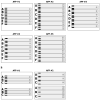Multistrip western blotting to increase quantitative data output
- PMID: 19378054
- PMCID: PMC2923389
- DOI: 10.1007/978-1-59745-542-8_17
Multistrip western blotting to increase quantitative data output
Abstract
The qualitative and quantitative measurements of protein abundance and modification states are essential in understanding their functions in diverse cellular processes. Typical western blotting, though sensitive, is prone to produce substantial errors and is not readily adapted to high-throughput technologies. Multistrip western blotting is a modified immunoblotting procedure based on simultaneous electrophoretic transfer of proteins from multiple strips of polyacrylamide gels to a single membrane sheet. In comparison with the conventional technique, Multistrip western blotting increases the data output per single blotting cycle up to tenfold, allows concurrent monitoring of up to nine different proteins from the same loading of the sample, and substantially improves the data accuracy by reducing immunoblotting-derived signal errors. This approach enables statistically reliable comparison of different or repeated sets of data, and therefore is beneficial to apply in biomedical diagnostics, systems biology, and cell signaling research.
Figures




Similar articles
-
Multistrip Western blotting: a tool for comparative quantitative analysis of multiple proteins.Methods Mol Biol. 2015;1312:197-226. doi: 10.1007/978-1-4939-2694-7_23. Methods Mol Biol. 2015. PMID: 26044004
-
Multistrip Western blotting to increase quantitative data output.Electrophoresis. 2007 Sep;28(18):3163-73. doi: 10.1002/elps.200700002. Electrophoresis. 2007. PMID: 17722184 Free PMC article.
-
Western blotting.Methods. 2006 Apr;38(4):283-93. doi: 10.1016/j.ymeth.2005.11.007. Methods. 2006. PMID: 16483794
-
A brief review of other notable protein blotting methods.Methods Mol Biol. 2009;536:367-84. doi: 10.1007/978-1-59745-542-8_38. Methods Mol Biol. 2009. PMID: 19378075 Review.
-
An overview of Western blotting for determining antibody specificities for immunohistochemistry.Methods Mol Biol. 2011;717:55-67. doi: 10.1007/978-1-61779-024-9_3. Methods Mol Biol. 2011. PMID: 21370024 Review.
Cited by
-
KDM6A and KDM6B play contrasting roles in nuclear transfer embryos revealed by MERVL reporter system.EMBO Rep. 2018 Dec;19(12):e46240. doi: 10.15252/embr.201846240. Epub 2018 Nov 2. EMBO Rep. 2018. PMID: 30389724 Free PMC article.
-
Targeting promiscuous heterodimerization overcomes innate resistance to ERBB2 dimerization inhibitors in breast cancer.Breast Cancer Res. 2019 Mar 21;21(1):43. doi: 10.1186/s13058-019-1127-y. Breast Cancer Res. 2019. PMID: 30898150 Free PMC article.
-
Interindividual Regulation of the Breast Cancer Resistance Protein/ABCG2 Transporter in Term Human Placentas.Drug Metab Dispos. 2018 May;46(5):619-627. doi: 10.1124/dmd.117.079228. Epub 2018 Jan 31. Drug Metab Dispos. 2018. PMID: 29386232 Free PMC article.
-
A Computational Framework for Prediction and Analysis of Cancer Signaling Dynamics from RNA Sequencing Data-Application to the ErbB Receptor Signaling Pathway.Cancers (Basel). 2020 Oct 7;12(10):2878. doi: 10.3390/cancers12102878. Cancers (Basel). 2020. PMID: 33036375 Free PMC article.
-
A high-density immunoblotting methodology for quantification of total protein levels and phosphorylation modifications.Sci Rep. 2015 Nov 23;5:16995. doi: 10.1038/srep16995. Sci Rep. 2015. PMID: 26592927 Free PMC article.
References
-
- Soundy P, Harvey B. Western Blotting as a Diagnostic Method. In: Walker JM, Rapley R, editors. Medical Biomethods Handbook. Totowa: Humana Press; 2005. pp. 43–62.
-
- Omenn GS. Strategies for plasma proteomic profiling of cancers. Proteomics. 2006;6(20):5662–73. - PubMed
-
- Hueber W, Robinson WH. Proteomic biomarkers for autoimmune disease. Proteomics. 2006;6(14):4100–4105. - PubMed
-
- Fardilha M, Wu W, Sa R, et al. Alternatively spliced protein variants as potential therapeutic targets for male infertility and contraception. Ann N Y Acad Sci. 2004;1030:468–478. - PubMed
-
- Ducruet AP, Vogt A, Wipf P, Lazo JS. Dual specificity protein phosphatases: therapeutic targets for cancer and Alzheimer's disease. Annu Rev Pharmacol Toxicol. 2005;45:725–750. - PubMed
Publication types
MeSH terms
Substances
Grants and funding
LinkOut - more resources
Full Text Sources

